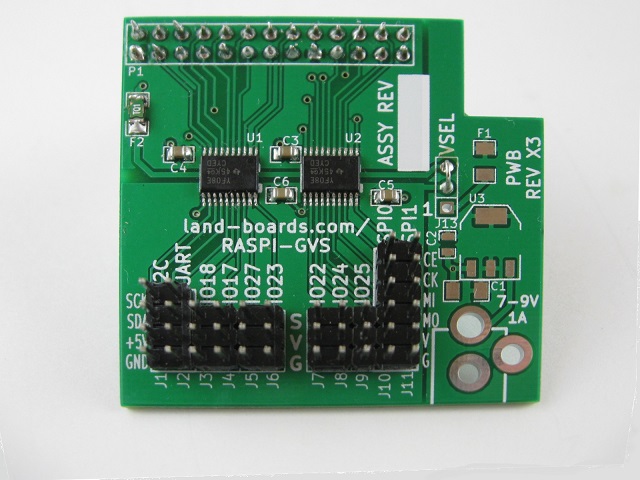Difference between revisions of "RasPi-GVS"
Blwikiadmin (talk | contribs) |
Blwikiadmin (talk | contribs) |
||
| Line 18: | Line 18: | ||
* Jumper to select power for GVS (allows the GVS connectors to be powered from either the on-board regulator (option) or powered from the Raspberry Pi) | * Jumper to select power for GVS (allows the GVS connectors to be powered from either the on-board regulator (option) or powered from the Raspberry Pi) | ||
* 49x49mm card form factor | * 49x49mm card form factor | ||
| + | |||
| + | === Voltage Translators === | ||
| + | |||
| + | The Raspi-GVS board uses Texas Instrument TXS0108 voltage translators. | ||
| + | |||
| + | Voltage Translators Features | ||
| + | No Direction-Control Signal Needed | ||
| + | Max Data Rates | ||
| + | 60 Mbps (Push Pull) | ||
| + | 2 Mbps (Open Drain) | ||
| + | 1.2 V to 3.6 V on A Port and 1.65 V to 5.5 V on | ||
| + | B Port (VCCA ≤ VCCB) | ||
| + | No Power-Supply Sequencing Required – | ||
| + | Either VCCA or VCCB Can Be Ramped First | ||
| + | Latch-Up Performance Exceeds 100 mA Per JESD 78, Class II | ||
| + | ESD Protection Exceeds JESD 22 (A Port) | ||
| + | 2000-V Human-Body Model (A114-B) | ||
| + | 150-V Machine Model (A115-A) | ||
| + | 1000-V Charged-Device Model (C101) | ||
| + | IEC 61000-4-2 ESD (B Port) | ||
| + | ±6-kV Air-Gap Discharge | ||
| + | ±8-kV Contact Discharge | ||
| + | Voltage Translators Architecture | ||
| + | Datasheet | ||
| + | |||
| + | The TXS0108E can be used in level-translation applications for interfacing devices or systems operating at different interface voltages with one another. The TXS0108E is ideal for use in applications where an open-drain driver is connected to the data I/Os. The TXS0108E can also be used in applications where a push-pull driver is connected to the data I/Os, but the TXB0104 might be a better option for such push-pull applications. The TXS0108E device is a semi-buffered auto-direction-sensing voltage translator design is optimized for translation applications (e.g. MMC Card Interfaces) that require the system to start out in a low-speed open-drain mode and then switch to a higher speed push-pull mode. | ||
| + | |||
| + | TXS0108Arch.PNG | ||
| + | |||
| + | To address these application requirements, a semi-buffered architecture design is used and is illustrated above (see Figure 1). Edge-rate accelerator circuitry (for both the high-to-low and low-to-high edges), a High-Ron n-channel pass-gate transistor (on the order of 300 Ω to 500 Ω) and pull-up resistors (to provide DC-bias and drive capabilities) are included to realize this solution. A direction-control signal (to control the direction of data flow from A to B or from B to A) is not needed. The resulting implementation supports both low-speed open-drain operation as well as high-speed push-pull operation. | ||
| + | |||
| + | When transmitting data from A to B ports, during a rising edge the One-Shot (OS3) turns on the PMOS transistor (P2) for a short-duration and this speeds up the low-to-high transition. Similarly, during a falling edge, when transmitting data from A to B, the One-Shot (OS4) turns on NMOS transistor (N2) for a short-duration and this speeds up the high-to-low transition. The B-port edge-rate accelerator consists of one-shots OS3 and OS4, Transistors P2 and N2 and serves to rapidly force the B port high or low when a corresponding transition is detected on the A port. | ||
| + | |||
| + | When transmitting data from B to A ports, during a rising edge the One-Shot (OS1) turns on the PMOS transistor (P1) for a short-duration and this speeds up the low-to-high transition. Similarly, during a falling edge, when transmitting data from B to A, the One-Shot (OS2) turns on NMOS transistor (N1) for a short-duration and this speeds up the high-to-low transition. The A-port edge-rate accelerator consists of one-shots OS1 and OS2, Transistors P1 and N1 components and form the edge-rate accelerator and serves to rapidly force the A port high or low when a corresponding transition is detected on the B port. | ||
| + | |||
| + | Power Supply | ||
| + | The RaspPi-GVS offers flexible power supply options. The 5V for the GVS Connnectors and translators can come either from the Raspberry Pi or from the 5V power supply on the RaspPi-GVS. | ||
| + | |||
| + | A three pin header and jumpers are used to select the voltage source(s). Installing a single jumper from pins 2 to 3 allow the Raspberry Pi to power the GVC connectors and voltage translators. Installing a jumper from 1 to 2 powers the GVS connections and voltage translators from the 5V power supply. | ||
== Drivers == | == Drivers == | ||
Revision as of 13:35, 24 January 2020
Features
- Daughtercard to the Raspberry Pi (you supply the Raspberry Pi)
- 3.3V to 5V bidirectional voltage translators on GPIO (General Purpose Input/Output) lines
- (7) 5V GPIO lines on GVS connectors
- (2) 5V SPI interfaces (can be used as 5 GPIO lines)
- (1) 5V UART (serial port) interface
- (1) 5V I2C interface (can be used as 2 GPIO lines)
- GPIO_4 enables/disables the voltage translators
- Resettable Fuse protection on the 5V power lines
- 7-9V input voltage on the Power Supply connector (option) which has a regulator that can power the GVS connectors (within thermal limits of the regulator) removing any 5V load from the Raspberry Pi itself
- Jumper to select power for GVS (allows the GVS connectors to be powered from either the on-board regulator (option) or powered from the Raspberry Pi)
- 49x49mm card form factor
Voltage Translators
The Raspi-GVS board uses Texas Instrument TXS0108 voltage translators.
Voltage Translators Features No Direction-Control Signal Needed Max Data Rates 60 Mbps (Push Pull) 2 Mbps (Open Drain) 1.2 V to 3.6 V on A Port and 1.65 V to 5.5 V on B Port (VCCA ≤ VCCB) No Power-Supply Sequencing Required – Either VCCA or VCCB Can Be Ramped First Latch-Up Performance Exceeds 100 mA Per JESD 78, Class II ESD Protection Exceeds JESD 22 (A Port) 2000-V Human-Body Model (A114-B) 150-V Machine Model (A115-A) 1000-V Charged-Device Model (C101) IEC 61000-4-2 ESD (B Port) ±6-kV Air-Gap Discharge ±8-kV Contact Discharge Voltage Translators Architecture Datasheet
The TXS0108E can be used in level-translation applications for interfacing devices or systems operating at different interface voltages with one another. The TXS0108E is ideal for use in applications where an open-drain driver is connected to the data I/Os. The TXS0108E can also be used in applications where a push-pull driver is connected to the data I/Os, but the TXB0104 might be a better option for such push-pull applications. The TXS0108E device is a semi-buffered auto-direction-sensing voltage translator design is optimized for translation applications (e.g. MMC Card Interfaces) that require the system to start out in a low-speed open-drain mode and then switch to a higher speed push-pull mode.
TXS0108Arch.PNG
To address these application requirements, a semi-buffered architecture design is used and is illustrated above (see Figure 1). Edge-rate accelerator circuitry (for both the high-to-low and low-to-high edges), a High-Ron n-channel pass-gate transistor (on the order of 300 Ω to 500 Ω) and pull-up resistors (to provide DC-bias and drive capabilities) are included to realize this solution. A direction-control signal (to control the direction of data flow from A to B or from B to A) is not needed. The resulting implementation supports both low-speed open-drain operation as well as high-speed push-pull operation.
When transmitting data from A to B ports, during a rising edge the One-Shot (OS3) turns on the PMOS transistor (P2) for a short-duration and this speeds up the low-to-high transition. Similarly, during a falling edge, when transmitting data from A to B, the One-Shot (OS4) turns on NMOS transistor (N2) for a short-duration and this speeds up the high-to-low transition. The B-port edge-rate accelerator consists of one-shots OS3 and OS4, Transistors P2 and N2 and serves to rapidly force the B port high or low when a corresponding transition is detected on the A port.
When transmitting data from B to A ports, during a rising edge the One-Shot (OS1) turns on the PMOS transistor (P1) for a short-duration and this speeds up the low-to-high transition. Similarly, during a falling edge, when transmitting data from B to A, the One-Shot (OS2) turns on NMOS transistor (N1) for a short-duration and this speeds up the high-to-low transition. The A-port edge-rate accelerator consists of one-shots OS1 and OS2, Transistors P1 and N1 components and form the edge-rate accelerator and serves to rapidly force the A port high or low when a corresponding transition is detected on the B port.
Power Supply The RaspPi-GVS offers flexible power supply options. The 5V for the GVS Connnectors and translators can come either from the Raspberry Pi or from the 5V power supply on the RaspPi-GVS.
A three pin header and jumpers are used to select the voltage source(s). Installing a single jumper from pins 2 to 3 allow the Raspberry Pi to power the GVC connectors and voltage translators. Installing a jumper from 1 to 2 powers the GVS connections and voltage translators from the 5V power supply.

